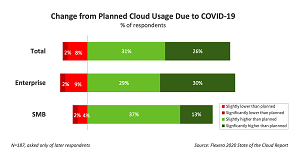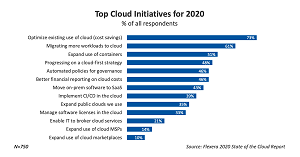News
Survey Says COVID-19 Increased Business Cloud Use
Confirming other data, a new State of the Cloud report from Flexera indicates the COVID-19 pandemic increased the use of cloud computing platforms among enterprises and small and medium-sized businesses.
Because the pandemic struck during the first-quarter survey process, only a small percentage of respondents to the "Flexera 2020 State of the Cloud Report" addressed the question that was added to gauge changes from planned cloud usage due to COVID-19.
Nevertheless, 57 percents of the respondents who replied after the pandemic struck said cloud usage increased slightly (31 percent) or significantly (26 percent).
 [Click on image for larger view.] Change in Planned Cloud Usage (source: Flexera).
[Click on image for larger view.] Change in Planned Cloud Usage (source: Flexera).
Furthermore, organizations are tapping multiple cloud services for the most part, according to the industry study involving 750 enterprise and SMB participants.
The survey report found that most (93 percent) of respondents said they had a multicloud strategy. On average, respondents used 2.2 public clouds and 2.2 private clouds. The report also found that 87 percent of organizations had adopted a "hybrid" approach, where both public and private cloud infrastructures were used.
However, this multicloud use, when further defined, was described by respondents as being mostly used (55 percent) for the running of "apps siloed on different clouds."
Respondents did describe some mixed cloud use, though, namely:
- "Data integration between clouds" (41 percent)
- "Workload mobility between clouds" (36 percent)
- "Disaster recovery/failover between clouds" (35 percent)
- "Individual apps span public and private clouds" (34 percent)
Top public cloud providers, per the respondents, included Amazon Web Services (76 percent), Microsoft Azure (63 percent) and Google Cloud (35 percent). About half of workloads (53 percent) and data (50 percent) were housed in public clouds, according to the respondents.
Managed service provider (MSP) use was tracked in the survey. Respondents said they used MSPs for "most" public cloud use (26 percent) or for "some" public cloud use (21 percent).
Only about one-third of the respondents used multicloud management tools, or tools for cloud security, governance or cost management functions. Flexera is a Chicago-based provider of IT and asset management solutions, so much of the survey probed those sorts of issues.
Top Cloud Challenges
A top cloud migration challenge was "understanding app dependencies," according to 63 percent of respondents. Some other migration challenges listed in the report included "assessing technical feasibility" (47 percent), "assessing on-prem vs. cloud costs" (41 percent) and "rightsizing/selecting best instance" (39 percent).
However, the overall top cloud challenges, per respondents, included security (81 percent), managing cloud spend (79 percent), governance (77 percent) and a perceived "lack of resources/expertise" (77 percent).
Cloud software licensing was deemed to be a fuzzy area in terms of understanding cost implications (56 percent). Other conundrums included following cloud licensing rules (49 percent), understanding cloud licensing complexity (48 percent) and having control over using too many licenses (45 percent).
 [Click on image for larger view.] Cloud Initiatives (source: Flexera).
[Click on image for larger view.] Cloud Initiatives (source: Flexera).
In terms of the respondents' present-day cloud initiatives, as the above graphic shows, they were mostly seeking to optimize costs associated with cloud use (73 percent), followed by migrating more workloads to the cloud (61 percent), expanding the use of containers (51 percent) and going cloud-first (48 percent).
Cloud Tools Used
The study found a strong use of Docker containers by the respondents, as well as the Kubernetes container orchestration solution. It found 65 percent reporting the use of Docker containers, while 58 percent used Kubernetes. One top challenge for using containers was described as a "lack of resources/expertise" per 41 percent of respondents.
The top DevOps configuration tools used by respondents included Ansible (43 percent), Terraform (42 percent), Chef (33 percent), Puppet (32 percent) and Salt (17 percent).
Overall, 63 percent of respondents said they spent "$1.2 million or more per year" on public cloud services, while 26 percent spent "at least 12 million" per year on the same. Respondents also indicated that their current cloud spending was over budget by an average of 23 percent. Some cost-saving measures taken by the respondents included using automation to shut down workloads after hours (51 percent) as well as right-sizing instances (49 percent).
Platform-as-a-Service (PaaS) was mostly used "to accelerate dev" (49 percent) and "reduce costs" (58 percent). Fears about PaaS vendor lock-in appeared to be low among the respondents, with the report stating that "today, only 30 percent of respondents limits PaaS usage for this reason."
Demographics
Flexera's survey, conducted in February and March, had a predominantly larger enterprise representation, with 554 enterprise respondents versus 196 SMB respondents. An enterprise was defined as having 1,000 or more employees, while an SMB was defined as having fewer than 1,000 employees. Respondents mostly (64 percent) were located in the Americas. They also predominantly (43 percent) described their professional level as being "architect."
The survey largely (53 percent) included users with "heavy cloud" use experience, with 30 percent described as having "intermediate" experience, 7 percent as "beginner" and 10 percent as "watcher" (involved with planning).
About the Author
Kurt Mackie is senior news producer for 1105 Media's Converge360 group.